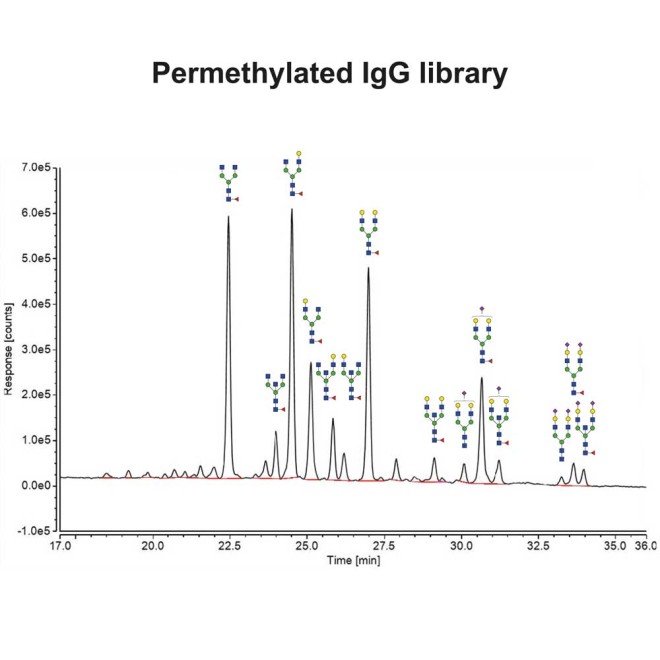IgG N-glycan (Permethylated)
References
Beyer B, Schuster M, Jungbauer A, Lingg N. Microheterogeneity of Recombinant Antibodies: Analytics and Functional Impact. Biotechnol J. 2018 Jan;13(1). doi: 10.1002/biot.201700476. Epub 2017 Sep 25. Review.
Sha S, Agarabi C, Brorson K, Lee DY, Yoon S. N-Glycosylation Design and Control of Therapeutic Monoclonal Antibodies. Trends Biotechnol. 2016 Oct;34(10):835-846. doi: 10.1016/j.tibtech.2016.02.013. Epub 2016 Mar 22. Review
Liu L. Antibody glycosylation and its impact on the pharmacokinetics and pharmacodynamics of monoclonal antibodies and Fc-fusion proteins. J Pharm Sci. 2015 Jun;104(6):1866-1884. doi: 10.1002/jps.24444. Epub 2015 Apr 14.
Jefferis R. Recombinant antibody therapeutics: the impact of glycosylation on mechanisms of action. Trends Pharmacol Sci. 2009 Jul;30(7):356-62. doi: 10.1016/j.tips.2009.04.007. Epub 2009 Jun 22. Review.
Jefferis R. Glycosylation of recombinant antibody therapeutics. Biotechnol Prog 21: pp11-16, 2005
Fernandes D. Demonstrating Comparability of Antibody Glycosylation during Biomanufacturing. European Biopharmaceutical Review. Summer 2005. pp 106 -110
IgG N-glycan library, Permethylated, approx 20 MS runs.
A mixture of fucosylated, bi-antennary glycan standards with variable sialylation released from human IgG antibody glycoprotein and permethylated.
Ludger now offers a permethylated IgG glycan library to use as a system suitability standard during MS analysis. Ludger also offers a C13 version which can be used as an internal standard in the same MALDI chip spot as your C12-labelled permethylated glycans.
Product specification
Our IgG glycan library is a mixture of nonfucosylated and fucosylated, bi-antennary glycan standards with variable sialylation released from human IgG antibody glycoprotein. They are available unlabeled and labeled with a variety of tags.
We also supply an IgG glycoprotein standard for use during glycan release and labeling.
“Glycosylation can significantly affect the in vivo safety and efficacy profiles of therapeutic recombinant monoclonal antibodies (rMAbs). In particular, glycans can have a marked influence on IgG Fc effector functions and changes in antibody glycosylation are a major cause of batch-to-batch variability during production. For these reasons, it is essential to measure and control antibody glycosylation accurately and reliably.” This introduction was copied from Dr. Daryl Fernandes’ article Demonstrating Comparability of Antibody Glycosylation during Biomanufacturing
Sources: The IgG glycan library in these products are released from an IgG standard that is purified from human serum. IgG exists in a variety of glycoforms containing bi-antennary oligosaccharides with variable sialylation.
Form: Dry. Dried by centrifugal evaporation from an aqueous solution.
Amount supplied
CLIBN-IGG-01 25 µgs – unlabeled
CAB-IGG-01 200 pmol – 2-AB labeled
CAPTS-IGG-01 10 pmol – APTS labeled
CPROC-IGG-02 50 pmol – procainamide labeled
CPM-IGG-01 20 MS runs – permethylated
CPM-C13-IGG-01 20 MS runs – permethylated with heavy (13C) MeI
Permethylated IgG glycan standards for MS analysis
Mass spectrometry (MS) is a useful tool in determining the molecular weights but the sensitivity can be low especially where there are many different structures. Carbohydrates often contain carboxy, amino, sulphate, and phosphate groups. The nature and the position of these groups on the residue, as well as the position of this residue within the glycan may be difficult to determine. Permethylation of glycans converts hydrogen groups to methyl groups which renders the glycans hydrophobic; the conversion stabilises sialic acids and can increase signal intensity in mass measurements.
We now offer a LudgerTag a permethylated IgG glycan library to use as a system suitability standard during MS analysis. We also offer a C13 version which can be used as an internal standard in the same MALDI chip spot as your C12-labelled permethylated glycans.
Purity: > 90% pure as assessed by a combination of 1 H-NMR and HPLC, and CE
Storage: -20˚C both before and after dissolution. The products are stable for at least 5 years as supplied.
Shipping: The product can be shipped at ambient when dry. After dissolution, ship on dry ice.
Handling: Allow the unopened vial to reach ambient temperature and tap unopened on a solid surface to ensure that most of the lyophilized material is at the bottom of the vial. Gently remove the cap, add the desired volume of reconstitution medium, re-cap and mix thoroughly to bring all the oligosaccharide into solution. For maximal recovery of oligosaccharide, ensure that the cap lining is also rinsed and centrifuge the reconstituted vial briefly before use. Ensure that any glass, plasticware or solvents used are free of glycosidases and environmental carbohydrates. Minimise exposure to elevated temperatures or extremes of pH. High temperatures and low pH will cause desialylation. High pH will cause epimerisation of the reducing terminus GlcNAc.
Safety: This product is non-hazardous and has been purified from natural sources certified to be free of all hazardous material including pathogenic biological agents.
Ordering Information
| Ludger Cat. # | Description |
|---|---|
| CPM-IGG-01 | N-glycan IgG library, permethylated |
| CPM-C13-IGG-01 | N-glycan IgG library, permethylated with heavy (13C) MeI |
To order or request a quotation, please email us at info@ludger.com
Please visit our website: www.ludger.com



